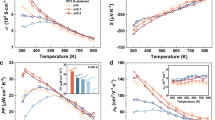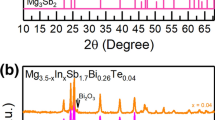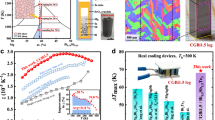Abstract
Thermoelectric devices require thermoelectric materials with high figure-of-merit (ZT) values in the operating temperature range. In recent years, the Zintl phase compound, n-Mg3Sb2, has received much attention owing to its rich chemistry and structural complexity. However, it hardly achieves high ZT values throughout the medium temperature range. Herein, by increasing the sintering temperature as much as possible, we successfully increased the average grain size of the compound by 15 times, and the grain boundary scattering was manipulated to obtain high carrier mobility of up to 180 cm2 V−1 s−1. Simultaneously, we optimized the Mg content for ultralow lattice thermal conductivity. We first doped the Mg3Sb2-based materials with boron for higher sintering temperature, good thermal stability, and higher hardness. The synergistic optimization of electrical and thermal transport resulted in excellent ZT values (0.62 at 300 K, 1.81 at 773 K) and an average ZT of 1.4 (from 300 to 773 K), which are higher than the state-of-the-art values for n-type thermoelectric materials, demonstrating a high potential in device applications.
摘要
器件应用要求热电材料在服役温度范围内具有持续的高热 电优值. 近年来, Zintl相化合物n-Mg3Sb2由于丰富的化学性质和结 构复杂性而受到广泛关注, 但是, n-Mg3Sb2难以在整个中温范围内 保持良好的热电性能. 本文通过提高烧结温度, 使合金平均晶粒尺 寸增加了15倍, 调控了晶界散射从而使载流子迁移率提高至 180 cm2 V−1 s−1. 同时, 更高的烧结温度优化了Mg成分以获得超低 晶格热导率; 采用硼掺杂获得了良好的热稳定性和更高的硬度. 电 热输运特性的协同优化使得硼掺杂Mg3Sb2合金的热电性能在全温 域提高明显, 热电优值为0.62 (300 K)–1.81 (773 K), 在300–773 K之 间的平均热电优值高达1.4, 在热电器件应用方面极具潜力.
Similar content being viewed by others
References
Champier D. Thermoelectric generators: A review of applications. Energy Convers Manage, 2017, 140: 167–181
Liu W, Jie Q, Kim HS, et al. Current progress and future challenges in thermoelectric power generation: From materials to devices. Acta Mater, 2015, 87: 357–376
Goldsmid HJ. Thermoelectric Refrigeration. New York: Springer, 2013
Chen ZG, Han G, Yang L, et al. Nanostructured thermoelectric materials: Current research and future challenge. Prog Nat Sci-Mater Int, 2012, 22: 535–549
Hong M, Chen ZG, Zou J. Fundamental and progress of Bi2Te3-based thermoelectric materials. Chin Phys B, 2018, 27: 048403
Pietrzyk K, Ohara B, Watson T, et al. Thermoelectric module design strategy for solid-state refrigeration. Energy, 2016, 114: 823–832
Salvador JR, Cho JY, Ye Z, et al. Conversion efficiency of skutterudite-based thermoelectric modules. Phys Chem Chem Phys, 2014, 16: 12510–12520
DiSalvo FJ. Thermoelectric cooling and power generation. Science, 1999, 285: 703–706
LaLonde AD, Pei Y, Wang H, et al. Lead telluride alloy thermoelectrics. Mater Today, 2011, 14: 526–532
Enescu D, Virjoghe EO. A review on thermoelectric cooling parameters and performance. Renew Sustain Energy Rev, 2014, 38: 903–916
Shi XL, Zou J, Chen ZG. Advanced thermoelectric design: From materials and structures to devices. Chem Rev, 2020, 120: 7399–7515
Hussain QE, Brigham DR, Maranville CW. Thermoelectric exhaust heat recovery for hybrid vehicles. SAE Int J Engines, 2009, 2: 1132–1142
He J, Tritt TM. Advances in thermoelectric materials research: Looking back and moving forward. Science, 2017, 357: eaak9997
O’Brien RC, Ambrosi RM, Bannister NP, et al. Safe radioisotope thermoelectric generators and heat sources for space applications. J Nucl Mater, 2008, 377: 506–521
Zhu T, Liu Y, Fu C, et al. Compromise and synergy in high-efficiency thermoelectric materials. Adv Mater, 2017, 29: 1605884
Poudel B, Hao Q, Ma Y, et al. High-thermoelectric performance of nanostructured bismuth antimony telluride bulk alloys. Science, 2008, 320: 634–638
Tan G, Shi F, Hao S, et al. Non-equilibrium processing leads to record high thermoelectric figure of merit in PbTe-SrTe. Nat Commun, 2016, 7: 12167
Mori T. Novel principles and nanostructuring methods for enhanced thermoelectrics. Small, 2017, 13: 1702013
Hong M, Lyu W, Wang Y, et al. Establishing the golden range of Seebeck coefficient for maximizing thermoelectric performance. J Am Chem Soc, 2020, 142: 2672–2681
Zebarjadi M, Joshi G, Zhu G, et al. Power factor enhancement by modulation doping in bulk nanocomposites. Nano Lett, 2011, 11: 2225–2230
Pei Y, LaLonde AD, Wang H, et al. Low effective mass leading to high thermoelectric performance. Energy Environ Sci, 2012, 5: 7963–7969
Fu C, Zhu T, Liu Y, et al. Band engineering of high performance p-type FeNbSb based half-Heusler thermoelectric materials for figure of merit zT > 1. Energy Environ Sci, 2015, 8: 216–220
Hong M, Lyv W, Li M, et al. Rashba effect maximizes thermoelectric performance of GeTe derivatives. Joule, 2020, 4: 2030–2043
Fu C, Bai S, Liu Y, et al. Realizing high figure of merit in heavy-band p-type half-Heusler thermoelectric materials. Nat Commun, 2015, 6: 8144
Kim HS, Kang SD, Tang Y, et al. Dislocation strain as the mechanism of phonon scattering at grain boundaries. Mater Horiz, 2016, 3: 234–240
Hong M, Zheng K, Lyv W, et al. Computer-aided design of high-efficiency GeTe-based thermoelectric devices. Energy Environ Sci, 2020, 13: 1856–1864
Hong M, Wang Y, Feng T, et al. Strong phonon-phonon interactions securing extraordinary thermoelectric Ge1−xSbxTe with Zn-alloying-induced band alignment. J Am Chem Soc, 2018, 141: 1742–1748
Sootsman JR, Chung DY, Kanatzidis MG. New and old concepts in thermoelectric materials. Angew Chem Int Ed, 2009, 48: 8616–8639
Yang J, Stabler FR. Automotive applications of thermoelectric materials. J Elec Materi, 2009, 38: 1245–1251
Goldsmid HJ. Introduction to Thermoelectricity. New York: Springer, 2010
Shakouri A. Recent developments in semiconductor thermoelectric physics and materials. Annu Rev Mater Res, 2011, 41: 399–431
Xiao Y, Zhao LD. Seeking new, highly effective thermoelectrics. Science, 2020, 367: 1196–1197
Kajikawa T, Kimura N, Yokoyama T. Thermoelectric properties of intermetallic compounds: Mg3Bi2 and Mg3Sb2 for medium temperature range thermoelectric elements. In: Twenty-Second International Conference on Thermoelectrics. La Grande Motte, 2003. 305–308
Condron CL, Kauzlarich SM, Gascoin F, et al. Thermoelectric properties and microstructure of Mg3Sb2. J Solid State Chem, 2006, 179: 2252–2257
Bhardwaj A, Misra DK. Enhancing thermoelectric properties of a p-type Mg3Sb2-based Zintl phase compound by Pb substitution in the anionic framework. RSC Adv, 2014, 4: 34552–34560
Bhardwaj A, Chauhan NS, Misra DK. Significantly enhanced thermoelectric figure of merit of p-type Mg3Sb2-based Zintl phase compounds via nanostructuring and employing high energy mechanical milling coupled with spark plasma sintering. J Mater Chem A, 2015, 3: 10777–10786
Tamaki H, Sato HK, Kanno T. Isotropic conduction network and defect chemistry in Mg3+δSb2-based layered Zintl compounds with high thermoelectric performance. Adv Mater, 2016, 28: 10182–10187
Zhang J, Song L, Pedersen SH, et al. Discovery of high-performance low-cost n-type Mg3Sb2-based thermoelectric materials with multi-valley conduction bands. Nat Commun, 2017, 8: 13901
Zhang J, Song L, Borup KA, et al. New insight on tuning electrical transport properties via chalcogen doping in n-type Mg3Sb2-based thermoelectric materials. Adv Energy Mater, 2018, 8: 1702776
Sun X, Li X, Yang J, et al. Achieving band convergence by tuning the bonding ionicity in n-type Mg3Sb2. J Comput Chem, 2019, 40: 1693–1700
Liu Z, Wang Y, Mao J, et al. Lithium doping to enhance thermoelectric performance of MgAgSb with weak electron-phonon coupling. Adv Energy Mater, 2016, 6: 1502269
Chen C, Li X, Li S, et al. Enhanced thermoelectric performance of p-type Mg3Sb2 by lithium doping and its tunability in an anionic framework. J Mater Sci, 2018, 53: 16001–16009
Mao J, Shuai J, Song S, et al. Manipulation of ionized impurity scattering for achieving high thermoelectric performance in n-type Mg3Sb2-based materials. Proc Natl Acad Sci USA, 2017, 114: 10548–10553
Shuai J, Mao J, Song S, et al. Tuning the carrier scattering mechanism to effectively improve the thermoelectric properties. Energy Environ Sci, 2017, 10: 799–807
Chen X, Wu H, Cui J, et al. Extraordinary thermoelectric performance in n-type manganese doped Mg3Sb2 Zintl: High band degeneracy, tuned carrier scattering mechanism and hierarchical microstructure. Nano Energy, 2018, 52: 246–255
Mao J, Wu Y, Song S, et al. Anomalous electrical conductivity of n-type Te-doped Mg3.2Sb1.5Bi0.5. Mater Today Phys, 2017, 3: 1–6
Mao J, Wu Y, Song S, et al. Defect engineering for realizing high thermoelectric performance in n-Type Mg3Sb2-based materials ACS Energy Lett, 2017, 2: 2245–2250
Imasato K, Kang SD, Ohno S, et al. Band engineering in Mg3Sb2 by alloying with Mg3Bi2 for enhanced thermoelectric performance. Mater Horiz, 2018, 5: 59–64
Imasato K, Kang SD, Snyder GJ. Exceptional thermoelectric performance in Mg3Sb0.6Bi1.4 for low-grade waste heat recovery. Energy Environ Sci, 2019, 12: 965–971
Kanno T, Tamaki H, Sato HK, et al. Enhancement of average thermoelectric figure of merit by increasing the grain-size of Mg3.2Sb1.5Bi0.49Te0.01. Appl Phys Lett, 2018, 112: 033903
Kuo JJ, Kang SD, Imasato K, et al. Grain boundary dominated charge transport in Mg3Sb2-based compounds. Energy Environ Sci, 2018, 11: 429–434
Shi X, Sun C, Bu Z, et al. Revelation of inherently high mobility enables Mg3Sb2 as a sustainable alternative to n-Bi2Te3 thermoelectrics. Adv Sci, 2019, 6: 1802286
Shi X, Zhao T, Zhang X, et al. Extraordinary n-type Mg3SbBi thermoelectrics enabled by yttrium doping. Adv Mater, 2019, 31: 1903387
Wood M, Kuo JJ, Imasato K, et al. Improvement of low-temperature zT in a Mg3Sb2-Mg3Bi2 solid solution via Mg-vapor annealing. Adv Mater, 2019, 31: 1902337
Tritt T, Rowe D. Thermoelectrics Handbook: Macro to Nano. Boca Raton: CRC Press, 2005
Dresselhaus M, Chen G, Tang M, et al. New directions for low-dimensional thermoelectric materials. Adv Mater, 2007, 19: 1043–1053
Kauzlarich SM, Brown SR, Snyder GJ. Zintl phases for thermoelectric devices. Dalton Trans, 2007, 2099
Ohno S, Imasato K, Anand S, et al. Phase boundary mapping to obtain n-type Mg3Sb2-based thermoelectrics. Joule, 2018, 2: 141–154
Imasato K, Fu C, Pan Y, et al. Metallic n-type Mg3Sb2 single crystals demonstrate the absence of ionized impurity scattering and enhanced thermoelectric performance. Adv Mater, 2020, 32: 1908218
Delci Z, Shyamala D, Karuna S, et al. Enhancement of optical, thermal and hardness in KDP crystals by boron doping. Int J Chem Tech Res, 2012, 4: 816–826
Li HS, Qi YX, Gong JH, et al. High-pressure synthesis and characterization of thermal-stable boron-doped diamond single crystals. Int J Refractory Met Hard Mater, 2009, 27: 564–570
Yang S, Matejczyk DE, Determan W. High Temperature Stable Nanocrystalline SiGe Thermoelectric Material. U.S. Patent, 8,512,667. 2013-8-20
Imasato K, Ohno S, Kang SD, et al. Improving the thermoelectric performance in Mg3+xSb1.5Bi0.49Te0.01 by reducing excess Mg. APL Mater, 2018, 6: 016106
Shuai J, Ge B, Mao J, et al. Significant role of Mg stoichiometry in designing high thermoelectric performance for Mg3(Sb,Bi)2-based n-type Zintls. J Am Chem Soc, 2018, 140: 1910–1915
Harman TC, Taylor PJ, Walsh MP, et al. Quantum dot superlattice thermoelectric materials and devices Science, 2002, 297: 2229–2232
Yazawa K, Shakouri A Optimization of power and efficiency of thermoelectric devices with asymmetric thermal contacts. J Appl Phys, 2012, 111: 024509
Yue SY, Zhang X, Stackhouse S, et al. Methodology for determining the electronic thermal conductivity of metals via direct nonequilibrium ab initio molecular dynamics. Phys Rev B, 2016, 94: 075149
Jørgensen LR, Zhang J, Zeuthen CB, et al. Thermal stability of Mg3Sb1.475Bi0.475Te0.05 high performance n-type thermoelectric investigated through powder X-ray diffraction and pair distribution function analysis. J Mater Chem A, 2018, 6: 17171–17176
Murugasami R, Vivekanandhan P, Kumaran S, et al. Simultaneous enhancement in thermoelectric performance and mechanical stability of p-type SiGe alloy doped with Boron prepared by mechanical alloying and spark plasma sintering. J Alloys Compd, 2019, 773: 752–761
Chen B, Li J, Wu M, et al. Simultaneous enhancement of the thermoelectric and mechanical performance in one-step sintered n-type Bi2Te3-based alloys via a facile MgB2 doping strategy. ACS Appl Mater Interfaces, 2019, 11: 45746–45754
Shu R, Zhou Y, Wang Q, et al. Mg3+δSbxBi2−x family: A promising substitute for the state-of-the-art n-type thermoelectric materials near room temperature. Adv Funct Mater, 2019, 29: 1807235
Song SW, Mao J, Bordelon M, et al. Joint effect of magnesium and yttrium on enhancing thermoelectric properties of n-type Zintl Mg3+Y0.02Sb1.5Bi0.5. Mater Today Phys, 2019, 8: 25–33
Acknowledgements
This work was supported by the National Natural Science Foundation of China (51771065 and 51871082) and the Natural Science Foundation of Heilongjiang Province of China (ZD2020E003).
Author information
Authors and Affiliations
Contributions
Chen X and Sui J designed the experiment. Chen X and Qu N conducted the sample synthesis and performance testing. Qin D, Xue W and Wang Y performed the microstructure characterization. Chen X, Guo f, and Zhu J wrote this article with support and guidance from Cai W, Zhang Q, and Sui J. All authors contributed to the general discussion.
Corresponding authors
Additional information
Conflict of interest
The authors declare that they have no conflict of interest.
Xiaoxi Chen received his PhD degree in 2020 in materials science and engineering from Harbin Institute of Technology, China. His main research interests focus on the fabrication and properties of Zintl phase thermoelectric materials.
Jianbo Zhu is a PhD candidate in materials science and engineering at Harbin Institute of Technology. He received his BE degree from Harbin Institute of Technology in 2019. He mainly studies transport problems of electron and phonon using Boltzmann transport equation and first principles calculations.
Fengkai Guo is now a postdoctoral researcher at Harbin Institute of Technology, China. He received his doctorate in material science from Harbin Institute of Technology, China in 2020. His main research interests focus on the fabrication and properties of thermoelectric materials.
Jiehe Sui is currently a professor of material physics and chemistry at Harbin Institute of Technology. He received his PhD degree in materials science and engineering from Harbin Institute of Technology in 2006. After that, he spent two years as a visiting scholar at the University of Houston (2013–2015). His current research is mainly on thermoelectric materials and devices.
Supplementary Information
40843_2020_1559_MOESM1_ESM.pdf
Excellent thermoelectric performance of boron-doped n-type Mg3Sb2-based materials via the manipulation of grain boundary scattering and control of Mg content
Rights and permissions
About this article
Cite this article
Chen, X., Zhu, J., Qin, D. et al. Excellent thermoelectric performance of boron-doped n-type Mg3Sb2-based materials via the manipulation of grain boundary scattering and control of Mg content. Sci. China Mater. 64, 1761–1769 (2021). https://doi.org/10.1007/s40843-020-1559-4
Received:
Accepted:
Published:
Issue Date:
DOI: https://doi.org/10.1007/s40843-020-1559-4




